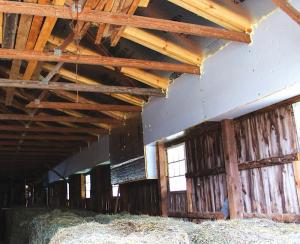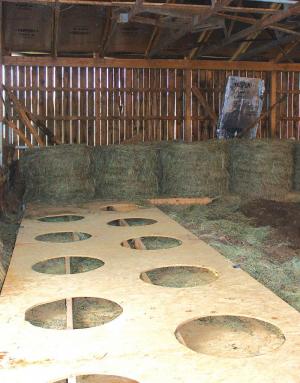2021 - Volume #45, Issue #4, Page #03
[ Sample Stories From This Issue | List of All Stories In This Issue | Print this story
| Read this issue]
Solar Heat Used To Dry Wet Bales
 |
 |
Weaver got his hay drier idea from a past article in Graze magazine (www.grazeonline.com; ph 608 455-3311) about a system in France for drying loose hay. This past spring, he described developing the bale dryer in a detailed, 5-part series in Graze magazine. Weaver and the editor of Graze agreed to share an overview of the process with FARM SHOW.
“I love dry hay, but can’t count on it because of our climate,” says Weaver. “To capture winter feed at optimum quality, we often have no choice but to harvest the crop as baleage or silage.”
Weaver built his 72-bale unit in 2020 after experiments in 2019 with a 3-bale prototype. The basic concept is collecting solar energy and blowing heated air up through the bales.
“We’ve learned that bales being dried should be of a uniform density without an overly dense outer layer,” says Weaver. “With the exception of 2 dense bales, we were impressed with the results. The hay was of good color and sweet smell. Cows preferred it to similar quality baleage fed alongside.”
For the large scale 2020 experiment, Weaver cleared out the bedding in the barn and prepped the area with a layer of wood chips for a smooth work surface.
He situated a blower near the center of the barn’s west wall. It feeds hot air from under the roof out to 8-ft. wide air ducts that run across the floor. Tongue and groove, 3/4-in. flooring underlayment was used to make the bale-drying ductwork that runs around the perimeter of the barn. The design allowed bales to be placed on the drying ducts by a skid steer.
The Weavers cut 20 and 32-in. diameter holes spaced 5 ft. on center in 2 parallel lines all along the platforms.
Solar energy is captured from under the barn’s steel roof. It’s then pulled down and forced up through the bales. Weaver built an 8-in. ductwork beneath the 4,500 sq. ft. roof using 1-in. thick foam board insulation. He painted the galvanized roof black to maximize heat capture. Weaver used a 35-hp. diesel engine to power the blower. It can move up to 1,500 ft. of air per minute.
“The first test came in June when we placed 68 bales, estimated at 40 percent moisture, on the drying ducts,” he says. “We ran the blower for a few hours to cool the bales down and then ran it during the daylight hours and shut it down at night,” says Weaver.
After several rounds of drying bales and a few problems, Weaver emphasizes the need for adequate air to all bales. His rule of thumb became about 1 hr. of dryer time in good drying conditions per percent of moisture in the bale.
Over the course of the summer, he dried 256 bales, about 60 percent of the total bales made. Initially, he turned bales upside down when they were close to being dried. This was a mistake as it caused more spoilage in the wetter area.
Weaver reported better feed utilization with less refusal by the cows, as well as better manure consistency, suggesting better feed digestion. He is experimenting with hay preservatives that may allow him to remove bales from the dryer at a higher moisture level and retain higher nutrient levels.
Weaver sees only 2 negatives so far. One is the noise of the engine and blower. The other is having to babysit the bales.
He estimates total material cost of about $11,000 for what he suspects could be a 20-year life. He estimates 1/2-gal. of diesel fuel to dry each bale.
Contact: FARM SHOW Followup, Nathan Weaver, 4225 East Milestrip Rd., Canastota, N.Y. 13032 (ph 315 684-3391).

Click here to download page story appeared in.

Click here to read entire issue
To read the rest of this story, download this issue below or click here to register with your account number.




